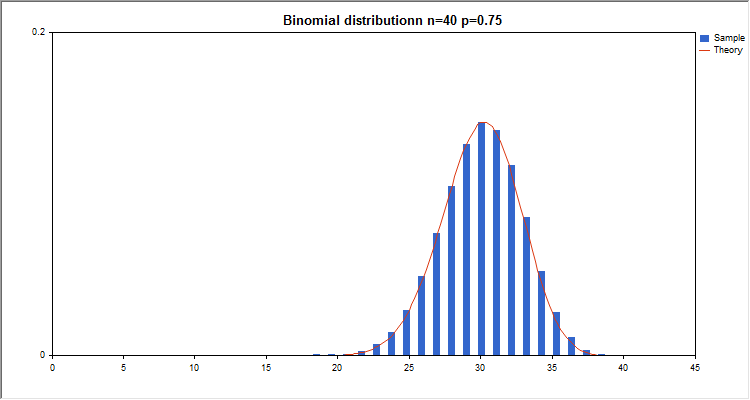#include <Graphics\Graphic.mqh>
#include <Math\Stat\Binomial.mqh>
#include <Math\Stat\Math.mqh>
#property script_show_inputs
//--- input parameters
input double n_par=40; // the number of tests
input double p_par=0.75; // probability of success for each test
//+------------------------------------------------------------------+
//| Script program start function |
//+------------------------------------------------------------------+
void OnStart()
{
//--- hide the price chart
ChartSetInteger(0,CHART_SHOW,false);
//--- initialize the random number generator
MathSrand(GetTickCount());
//--- generate a sample of the random variable
long chart=0;
string name="GraphicNormal";
int n=1000000; // the number of values in the sample
int ncells=20; // the number of intervals in the histogram
double x[]; // centers of the histogram intervals
double y[]; // the number of values from the sample falling within the interval
double data[]; // sample of random values
double max,min; // the maximum and minimum values in the sample
//--- obtain a sample from the binomial distribution
MathRandomBinomial(n_par,p_par,n,data);
//--- calculate the data to plot the histogram
CalculateHistogramArray(data,x,y,max,min,ncells);
//--- obtain the theoretically calculated data at the interval of [min,max]
double x2[];
double y2[];
MathSequence(0,n_par,1,x2);
MathProbabilityDensityBinomial(x2,n_par,p_par,false,y2);
//--- set the scale
double theor_max=y2[ArrayMaximum(y2)];
double sample_max=y[ArrayMaximum(y)];
double k=sample_max/theor_max;
for(int i=0; i<ncells; i++)
y[i]/=k;
//--- output charts
CGraphic graphic;
if(ObjectFind(chart,name)<0)
graphic.Create(chart,name,0,0,0,780,380);
else
graphic.Attach(chart,name);
graphic.BackgroundMain(StringFormat("Binomial distributionn n=%G p=%G",n_par,p_par));
graphic.BackgroundMainSize(16);
//--- plot all curves
graphic.CurveAdd(x,y,CURVE_HISTOGRAM,"Sample").HistogramWidth(6);
//--- and now plot the theoretical curve of the distribution density
graphic.CurveAdd(x2,y2,CURVE_LINES,"Theory").LinesSmooth(true);
graphic.CurvePlotAll();
//--- plot all curves
graphic.Update();
}
//+------------------------------------------------------------------+
//| Calculate frequencies for data set |
//+------------------------------------------------------------------+
bool CalculateHistogramArray(const double &data[],double &intervals[],double &frequency[],
double &maxv,double &minv,const int cells=10)
{
if(cells<=1) return (false);
int size=ArraySize(data);
if(size<cells*10) return (false);
minv=data[ArrayMinimum(data)];
maxv=data[ArrayMaximum(data)];
double range=maxv-minv;
double width=range/cells;
if(width==0) return false;
ArrayResize(intervals,cells);
ArrayResize(frequency,cells);
//--- define the interval centers
for(int i=0; i<cells; i++)
{
intervals[i]=minv+(i+0.5)*width;
frequency[i]=0;
}
//--- fill the frequencies of falling within the interval
for(int i=0; i<size; i++)
{
int ind=int((data[i]-minv)/width);
if(ind>=cells) ind=cells-1;
frequency[ind]++;
}
return (true);
}
|
![]()
